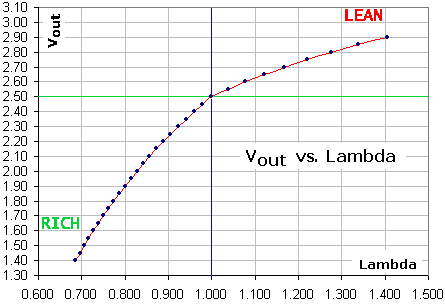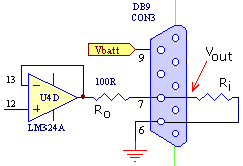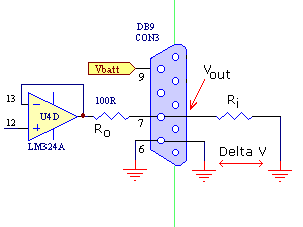DIY-WB Data
This document describes some of the DIY-WB unit's operating characteristics.
It is important to note that the unit is built using high tolerance components
but has no internal adjustments. Some variation is therefore expected between
each unit due to component tolerances and aging of both the sensor and the unit
itself.
Vout vs. Lambda

|
This graph shows the DIY-WB's Vout voltage against Lambda.
The Lambda measure is independent of the hydrocarbon fuel being used.
The stoichiometric point is where all the available oxygen has combined with
all the available fuel leaving no free residual oxygen. The stoichiometric
point is shown on the graph as the vertical blue line
at lambda of 1.00.
The stoichiometric output voltage is nominally 2.50 Volts and this
point is shown as the horizontal green line that
crosses the blue line at a lambda of 1.00.
|
Lambda and AFRs for different fuels
This table show the DIY-WB unit's measured
Lambda against the Vout voltage which is available at pin 7
of the male DB9 connector (pin 6 = GND).
Note that Lambda is a ratio of ratios and is 1.0 exactly
at the stoichiometric point for any given fuel.
This table shows the approximate AFRs for a number different common fuels.
As fuel compositions are seasonal and regional, the AFRs shown here
should be considered only as approximate.
The free-air Vout point of 4.00 volts is interesting from a number of viewpoints.
The free-air voltage will vary a little from location to location as there will
be differing trace concentrations of various hydrocarbon fuels in the atmosphere.
The free-air point can be used to calibrate the DIY-WB unit for
a particular sensor that has aged or is not close enough to 4.00 Volts
using the original calibration resistor that is built into the sensor's
8 pin Sumitomo connector.
As noted above, the basic WB unit's Vout may vary slightly from the specifications
shown here. The stoichiometric Vout of 2.50 may be a little higher or
lower (+/- 0.03 Volts) and the free-air Vout may be a little higher or
lower than 4.00. It's worth noting that the most important calibration
value is to get the difference between the stoic Vout (2.50) and free-air (4.00)
to be as close as possible to 1.50 Volts so that the interesting tuning AFR range
(AFRs of between 10 and 15 for petrol) are then most accurately represented.
When this 1.50 volt specification is achieved, and the unit's offset from the
nominal 2.50 volt stoic value is compensated for, quite reliable AFR values can
be obtained from the unit.
|
| Vout |
Lambda |
Petrol |
LPG |
Methanol |
Diesel |
| 1.40 |
0.686 |
10.08 |
10.63 |
4.39 |
9.94 |
| 1.45 |
0.696 |
10.23 |
10.79 |
4.45 |
10.09 |
| 1.50 |
0.706 |
10.38 |
10.94 |
4.52 |
10.24 |
| 1.55 |
0.716 |
10.53 |
11.10 |
4.58 |
10.39 |
| 1.60 |
0.727 |
10.69 |
11.27 |
4.65 |
10.54 |
| 1.65 |
0.739 |
10.86 |
11.45 |
4.73 |
10.71 |
| 1.70 |
0.750 |
11.03 |
11.63 |
4.80 |
10.88 |
| 1.75 |
0.762 |
11.20 |
11.81 |
4.88 |
11.05 |
| 1.80 |
0.774 |
11.38 |
12.00 |
4.95 |
11.23 |
| 1.85 |
0.787 |
11.57 |
12.20 |
5.04 |
11.41 |
| 1.90 |
0.800 |
11.76 |
12.40 |
5.12 |
11.60 |
| 1.95 |
0.814 |
11.96 |
12.61 |
5.21 |
11.80 |
| 2.00 |
0.828 |
12.17 |
12.83 |
5.30 |
12.00 |
| 2.05 |
0.842 |
12.38 |
13.05 |
5.39 |
12.21 |
| 2.10 |
0.857 |
12.60 |
13.29 |
5.49 |
12.43 |
| 2.15 |
0.873 |
12.83 |
13.53 |
5.59 |
12.66 |
| 2.20 |
0.889 |
13.07 |
13.78 |
5.69 |
12.89 |
| 2.25 |
0.905 |
13.31 |
14.03 |
5.79 |
13.13 |
| 2.30 |
0.923 |
13.57 |
14.31 |
5.91 |
13.39 |
| 2.35 |
0.941 |
13.84 |
14.59 |
6.03 |
13.65 |
| 2.40 |
0.960 |
14.11 |
14.88 |
6.14 |
13.92 |
| 2.45 |
0.980 |
14.40 |
15.18 |
6.27 |
14.20 |
| 2.50 |
1.000 |
14.70 |
15.50 |
6.40 |
14.50 |
| 2.55 |
1.037 |
15.25 |
16.08 |
6.64 |
15.04 |
| 2.60 |
1.078 |
15.84 |
16.70 |
6.90 |
15.62 |
| 2.65 |
1.121 |
16.48 |
17.38 |
7.17 |
16.26 |
| 2.70 |
1.169 |
17.18 |
18.11 |
7.48 |
16.95 |
| 2.75 |
1.220 |
17.93 |
18.91 |
7.81 |
17.69 |
| 2.80 |
1.276 |
18.76 |
19.78 |
8.17 |
18.50 |
| 2.85 |
1.337 |
19.66 |
20.73 |
8.56 |
19.39 |
| 2.90 |
1.405 |
20.66 |
21.78 |
8.99 |
20.38 |
| | . . . |
| 4.00 |
free-air (can be used for calibration) |
|
Input Impedance, Vout and the Real World

It is important to understand that the Tech Edge wideband unit (like any real world device)
has a non-zero output impedance (Ro).
Any device the wideband unit is connected to for the purposes of logging Vout will have
a non-infinite input impedance (Ri).
This means that there will be small differences between the logged voltage (as seen by
an ECM, etc.), and the voltage produced by the wideband unit. Generally if the logging
device has an input impedance greater than 100 k ohms then this effect can be ignored.
If the input impedance is 30 k or less then it starts to make a noticeable difference between
the actual and logged voltages (and hence measured AFR values).
We have created an eXcel spreadsheet to help you build a custom table
of Vout vs. AFR - See voutnew.xls.
You supply the output impedance Ro of the wideband unit (1,000 for version 1.0
and 100 for version 1.1/1.5) and the input impedance Ri of your device.
A graph is automatically generated.
Many people may not know the input impedance of their logger (or ECM, etc.)
but it can be determined by noting when half of an applied voltage is "lost"
across a resistor in series with the voltage.
Offset Voltages, Vout and the Real World

A further complication is that sometimes there will be a large enough difference
in voltage between the logging device (ECM, etc.) GROUND point and the Wideband
unit itself, that errors start to become apparent. These differences in GROUND
potential are simply a fact of life that result from non-zero resistance
between different GROUND points - this causes measured voltage differences when
currents flow.
These differences in voltage are normally called offset voltages
and they tend to remain fixed for a given installation (or vary with some stimulus such as
switching on headlights, etc).
Offset voltages tend to be a little tricky as they may be different for what otherwise
looks like the same installation.
Previous |
Oz DIY-WB Home |
Order Oz DIY-WB parts/units |
Copyright

Last updated 15 th Mayt 2003
Created 17th August 2002
| Tell me about broken links
This document is copyright © 2002, Tech Edge Pty. Ltd.
Previous |
Home |
Feedback |
Copyright



